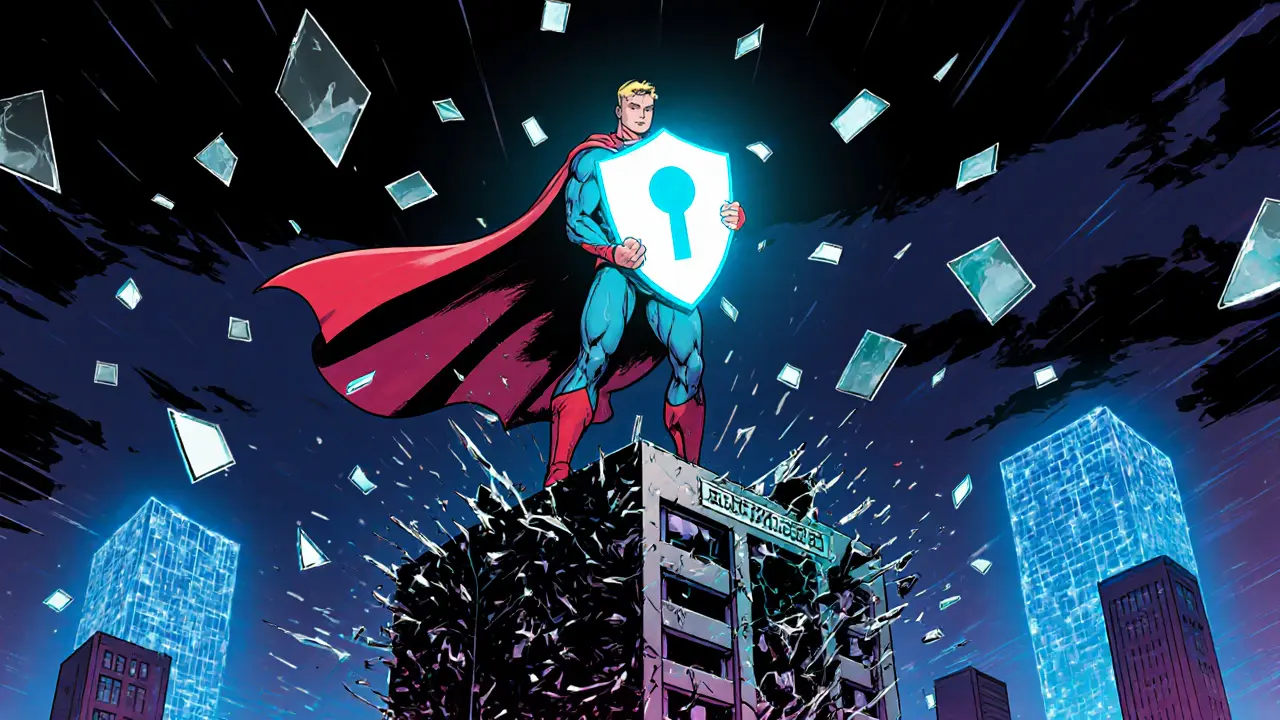Healthcare Data Breach Cost Calculator
Calculate Your Breach Risk
Based on industry data: Over 500 million medical records exposed annually at an average cost of $100 billion. Estimate your potential loss.
Estimated Breach Cost
Based on 2024 industry averages
Why Healthcare Still Struggles with Data Security
Every year, over 500 million medical records are exposed in data breaches. Hospitals, clinics, and insurance companies still rely on centralized databases - single points of failure that hackers target because they know where to look. One breach can leak names, diagnoses, Social Security numbers, and even insurance details for thousands of patients. And it’s not just outsiders. Internal errors, accidental exposures, and unauthorized staff access make up nearly 30% of incidents. Patients don’t control their own data. Providers can’t always trust what they see. And records? They’re full of mistakes - about 40% of them, according to health informatics studies.
How Blockchain Changes the Game
Blockchain doesn’t store your entire medical file in one place. Instead, it breaks your health data into encrypted fragments and scatters them across a network of computers. No single server holds everything. To reconstruct your record, you’d need multiple keys - and only you hold the master key. This isn’t theory. Platforms like MedRec and MedChain already use this model in pilot programs across U.S. and European hospitals. When your doctor needs to see your allergy history, you approve it with a tap on your phone. The system logs the access. It can’t be deleted. It can’t be changed. And if someone tries to tamper with it, the network knows instantly.
Smart Contracts: The Automatic Gatekeepers
Think of smart contracts as digital rules that run themselves. In healthcare, they decide who gets access, when, and for what purpose. If a researcher wants to use anonymized data from 10,000 diabetes patients, the smart contract checks: Is consent given? Is the request compliant with GDPR or HIPAA? Is the data being used only for approved research? If yes - access granted. If no - blocked. No middleman. No paperwork. No delays. This cuts down administrative costs by up to 30% in pilot programs. Insurance claims that used to take weeks now process in hours because the system verifies provider credentials, treatment codes, and patient eligibility automatically.
Patients Finally Have Control
For the first time, patients aren’t just subjects of data - they’re owners. You decide who sees your mental health records, your HIV status, or your genetic test results. You can revoke access anytime. You can even set time limits - like granting a specialist access only during your appointment window. In pilot programs in New Zealand and Canada, patients reported 68% higher trust in their care teams after using blockchain-based portals. One woman in Wellington shared that she finally felt safe sharing her cancer history with a new specialist because she could see exactly who accessed her file and when. That kind of transparency was impossible before.

How It Compares to Traditional Systems
| Feature | Blockchain-Based System | Traditional EHR System |
|---|---|---|
| Data Storage | Distributed across multiple nodes | Centralized server |
| Access Control | Patient-controlled via cryptographic keys | Admin-controlled, often over-permissive |
| Immutability | Records cannot be altered after entry | Records can be edited or deleted by staff |
| Audit Trail | Full, tamper-proof log of every access | Partial logs, easily manipulated |
| Interoperability | Designed to work across different systems | Often siloed, requires costly integration |
| Cost to Implement | High upfront, $500K-$2M for mid-sized hospital | Lower upfront, but ongoing maintenance costs add up |
Real-World Impact: Savings and Efficiency
Healthcare loses $100 billion a year to fraud, duplicate tests, and paperwork. Blockchain cuts that. How? By eliminating redundant records. If you’ve been to five clinics in the past year, each one used to create its own version of your history. Now, they all pull from one verified chain. No more asking patients to repeat their entire medical history. No more misdiagnoses from conflicting records. In a 2024 trial at a large Australian hospital network, blockchain reduced duplicate lab tests by 42% and cut administrative staffing needs for record reconciliation by 55%. Insurance companies using blockchain for claims saw fraud drop by 31% - because every transaction is traceable and verifiable.
Challenges You Can’t Ignore
It’s not magic. Blockchain has hurdles. First, integration. Most hospitals still use legacy EHR systems from vendors like Epic or Cerner. Connecting those to blockchain isn’t plug-and-play. It takes months of work. Second, training. Nurses and admins aren’t cryptographers. Teaching them to manage keys, understand consent flows, and interpret blockchain logs takes time - and money. Third, scalability. Right now, most healthcare blockchains handle 100-500 transactions per second. A busy ER does 200+ patient interactions per hour. That’s manageable, but not yet ready for nationwide scale. Energy use is also a concern, though newer platforms use proof-of-stake models that cut power use by 99% compared to Bitcoin-style chains.

Who’s Leading the Way?
MedChain and MedRec are the two most mature platforms in healthcare. MedChain works with 17 major U.S. hospital systems and focuses on secure data sharing between providers. MedRec, developed by MIT, is used in EU clinical trials and gives patients full control over data sharing permissions. In New Zealand, the HealthTech Alliance launched a pilot in 2024 using a permissioned blockchain to link primary care, pharmacies, and mental health services - all under patient control. Even insurance giants like UnitedHealthcare and Aetna are testing blockchain for claims verification. The market is growing fast - from $1.1 billion in 2021 to an expected $5.7 billion by 2026. Adoption is highest in North America and Europe, where privacy laws are strict and data breaches are costly.
What’s Next? The Future of Health Data
Blockchain won’t replace your doctor. But it will become the invisible backbone of your care. In the next three years, expect to see it tightly linked with AI - for example, an AI flagging a potential drug interaction based on your full, verified history, then alerting your provider only after you approve access. Remote monitoring devices like glucose patches or heart rate monitors will start writing data directly to blockchain, creating real-time, tamper-proof health dashboards. Telemedicine platforms will integrate blockchain to verify identities and secure video consultations. The goal isn’t to make tech complex - it’s to make your health data simple, safe, and yours.
Frequently Asked Questions
Can blockchain really prevent data breaches in healthcare?
Yes - but not in the way most people think. Blockchain doesn’t stop hackers from trying. It makes stolen data useless. If a hacker breaks into one node, they only get an encrypted fragment. To reconstruct a full record, they’d need to steal multiple keys from different nodes - and patients hold the only key that unlocks the full set. This makes mass breaches nearly impossible. In 2023, a hospital using MedRec reported zero data breaches despite repeated hacking attempts.
Do I need to understand cryptography to use blockchain health records?
No. You interact with it like an app. You tap to approve access, see who viewed your record, and revoke permissions. Behind the scenes, your phone or tablet handles the keys. Think of it like two-factor authentication - you don’t need to know how it works, just that it keeps you safe. Most platforms now offer simple PINs or biometric locks instead of complex key codes.
Is blockchain HIPAA and GDPR compliant?
Yes, if designed correctly. Blockchain doesn’t automatically make you compliant - but it enables compliance. Smart contracts can be coded to enforce HIPAA’s minimum necessary standard and GDPR’s right to erasure. For example, if a patient requests deletion, the system doesn’t delete the record (because blockchain is immutable). Instead, it permanently encrypts the data so it can never be accessed again - which meets legal requirements. Leading platforms like MedChain are certified for both regulations.
Can small clinics afford blockchain?
Right now, it’s expensive - $500,000 to $2 million for full rollout. But that’s changing. Cloud-based blockchain-as-a-service platforms are launching in 2025 that let small clinics pay a monthly fee instead of buying infrastructure. Think of it like switching from owning a server to using AWS. Some regional health networks are also pooling resources so multiple clinics share one blockchain system, cutting costs by 70%. By 2027, even solo practices may have access.
What happens if I lose my private key?
This is the biggest risk - and the reason why patient education matters. If you lose your key, you lose access to your data. That’s why leading platforms now offer recovery options: trusted contacts (like a family member or doctor) who can help reset access, or multi-signature recovery where two out of three people must approve. Some even use hardware tokens that store keys offline. But you still need to set this up in advance. Don’t wait until it’s too late.
Will blockchain replace electronic health records (EHRs)?
Not replace - enhance. Your doctor will still use Epic or Cerner. But now, instead of pulling from a siloed database, those systems pull verified data from the blockchain. It’s like upgrading your phone’s internet connection - the apps stay the same, but they load faster and more reliably. Blockchain becomes the secure backbone. EHRs become the user interface.
Where to Go From Here
If you’re a patient, ask your provider if they’re exploring blockchain-based record access. If you’re in healthcare IT, start by evaluating your biggest pain points: Is it fraud? Interoperability? Patient complaints about data access? Then look for pilot programs from MedChain, MedRec, or your regional health network. Don’t try to build your own blockchain - partner with vendors who’ve already solved the integration and compliance issues. The technology is ready. The question is: Are you ready to give patients control?

